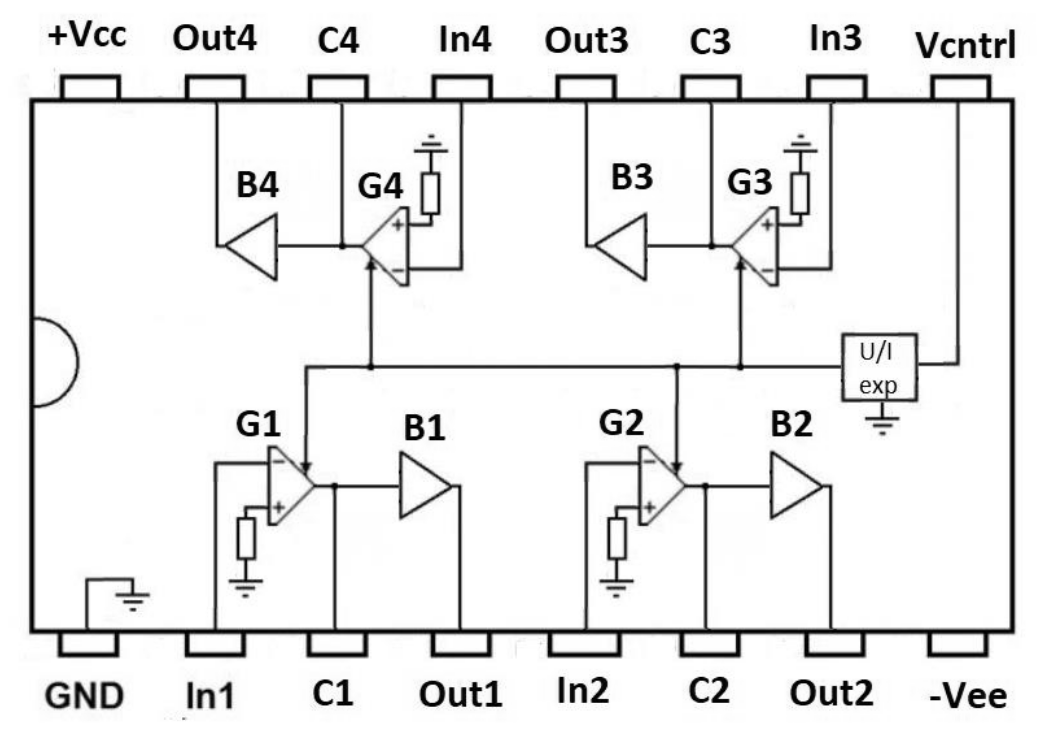Product information "Alfa Rpar - AS3109 - Voltage Controlled Filter (VCF)"
AS3109 is a high performance voltage controlled four-pole filter. The four independent sections may be interconnected to provide a wide variety of filter responses, such as low pass, high pass, band pass and all pass. A single input exponentially controls the frequency over greater than a 15 octave range with little control voltage feedthrough. AS3109 benefits from high input impedance buffers.
Features:
• voltage controllable range – till 15 octave
• accurate exponential frequency scale
• high input impedance buffers
• wide transconductance range
• low input offset voltage
• low control voltage feedthrough - 45 dB typical
Applications:
• for electronic music
Features:
• voltage controllable range – till 15 octave
• accurate exponential frequency scale
• high input impedance buffers
• wide transconductance range
• low input offset voltage
• low control voltage feedthrough - 45 dB typical
Applications:
• for electronic music
| Basic Function: | VCF |
|---|---|
| IC Package: | PDIP-16 (THT) |
| Pin Count: | 16 |
| Pin Pitch [mm]: | 2,54 |
| Technology: | THT |
Manufacturer / Hersteller:
ALFA RPAR AS
Ropažu iela 140
Vidzemes priekšpilsēta
LV-1006 Rīga
Lettland
alfa@alfarzpp.lv
Safety Instructions for Electronic and Mechanical Components
Intended Use:
• Electronic components, including potentiometers, knobs, switches, connectors, resistors, capacitors or integrated circuits (ICs), are designed for use in electronic circuits and devices.
• Use these components only for their intended purposes in electrical and electronic applications, according to their specified voltage, current, and environmental conditions.
• Any use outside the intended applications may result in malfunction or safety risks.
Handling and Installation
Installation:
• Handle electronic components with appropriate tools, such as tweezers, to avoid physical damage or exposure to electric shock.
• Ensure that the components are installed in the correct orientation and according to manufacturer specifications to avoid malfunction or damage to the circuit.
Storage:
• Store components in a dry, cool, and static-free environment to avoid damage from moisture, extreme temperatures, or electrostatic discharge (ESD).
• Avoid direct exposure to sunlight, which could affect component stability and performance.
Protection from Static Electricity:
• Use antistatic equipment (e.g., wrist straps, ESD mats) when handling electronic components to prevent electrostatic discharge, which can damage sensitive devices like ICs.
Compatibility:
• Make sure electronic components are compatible with the circuit in terms of voltage, current, and other technical specifications.
Warnings
Electrical Shock Hazard:
• Some components can retain charge even when disconnected. Use appropriate tools and take precautions when handling components to minimize the risk of electric shock.
Burn or Fire Risk:
• Overloading or misusing electronic components may result in overheating, which could lead to burning or fires. Ensure that components are used within their specified voltage and current ratings.
Danger from Misuse:
• Incorrect handling or use outside specified limits can damage the components or affect the performance and functionality of connected devices. Only use components within their specified tolerances and conditions.
Choking Hazard:
• Small electronic components can pose a choking hazard if swallowed. Keep components out of reach of children.
ALFA RPAR AS
Ropažu iela 140
Vidzemes priekšpilsēta
LV-1006 Rīga
Lettland
alfa@alfarzpp.lv
Safety Instructions for Electronic and Mechanical Components
Intended Use:
• Electronic components, including potentiometers, knobs, switches, connectors, resistors, capacitors or integrated circuits (ICs), are designed for use in electronic circuits and devices.
• Use these components only for their intended purposes in electrical and electronic applications, according to their specified voltage, current, and environmental conditions.
• Any use outside the intended applications may result in malfunction or safety risks.
Handling and Installation
Installation:
• Handle electronic components with appropriate tools, such as tweezers, to avoid physical damage or exposure to electric shock.
• Ensure that the components are installed in the correct orientation and according to manufacturer specifications to avoid malfunction or damage to the circuit.
Storage:
• Store components in a dry, cool, and static-free environment to avoid damage from moisture, extreme temperatures, or electrostatic discharge (ESD).
• Avoid direct exposure to sunlight, which could affect component stability and performance.
Protection from Static Electricity:
• Use antistatic equipment (e.g., wrist straps, ESD mats) when handling electronic components to prevent electrostatic discharge, which can damage sensitive devices like ICs.
Compatibility:
• Make sure electronic components are compatible with the circuit in terms of voltage, current, and other technical specifications.
Warnings
Electrical Shock Hazard:
• Some components can retain charge even when disconnected. Use appropriate tools and take precautions when handling components to minimize the risk of electric shock.
Burn or Fire Risk:
• Overloading or misusing electronic components may result in overheating, which could lead to burning or fires. Ensure that components are used within their specified voltage and current ratings.
Danger from Misuse:
• Incorrect handling or use outside specified limits can damage the components or affect the performance and functionality of connected devices. Only use components within their specified tolerances and conditions.
Choking Hazard:
• Small electronic components can pose a choking hazard if swallowed. Keep components out of reach of children.
Login


